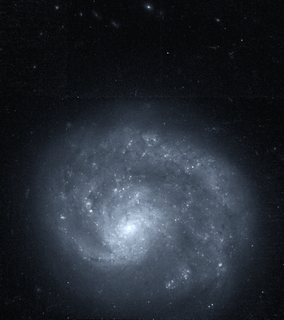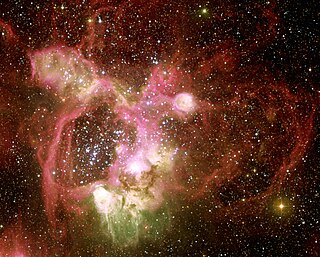
Dorado is a constellation in the southern sky. It was named in the late 16th century and is now one of the 88 modern constellations. Its name refers to the dolphinfish, which is known as dorado in Portuguese, although it has also been depicted as a swordfish. Dorado contains most of the Large Magellanic Cloud, the remainder being in the constellation Mensa. The South Ecliptic pole also lies within this constellation.

A star catalogue or star catalog, is an astronomical catalogue that lists stars. In astronomy, many stars are referred to simply by catalogue numbers. There are a great many different star catalogues which have been produced for different purposes over the years, and this article covers only some of the more frequently quoted ones. Star catalogues were compiled by many different ancient people, including the Babylonians, Greeks, Chinese, Persians, and Arabs. They were sometimes accompanied by a star chart for illustration. Most modern catalogues are available in electronic format and can be freely downloaded from space agencies data centres.

The Magellanic Clouds are two irregular dwarf galaxies visible in the Southern Celestial Hemisphere; they are members of the Local Group and are orbiting the Milky Way galaxy. Because both show signs of a bar structure, they are often reclassified as Magellanic spiral galaxies. The two galaxies are:

S Doradus is located 160,000 light years away, and is one of the brightest stars in the Large Magellanic Cloud (LMC), a satellite of the Milky Way. It is a Luminous Blue Variable and one of the most luminous stars known, but so far away that it is invisible to the naked eye.

R136 is the central concentration of stars in the NGC 2070 star cluster, which lies at the centre of the Tarantula Nebula in the Large Magellanic Cloud. When originally named it was an unresolved stellar object but is now known to include 72 class O and Wolf–Rayet stars within 5 parsecs of the centre of the cluster. The extreme number and concentration of young massive stars in this part of the LMC qualifies it as a starburst region.

NGC 4625 is a distorted dwarf galaxy in the constellation Canes Venatici. The galaxy is formally classified as a Sm galaxy, which means that its structure vaguely resembles the structure of spiral galaxies. The galaxy is sometimes referred to as a Magellanic spiral because of its resemblance to the Magellanic clouds.

HD 37974 a variable B[e] hypergiant in the Large Magellanic Cloud. It is surrounded by an unexpected dust disk.

N44 is an emission nebula with superbubble structure located in the Large Magellanic Cloud, a satellite galaxy of the Milky Way in the constellation Dorado. Originally catalogued in Karl Henize's "Catalogue of H-alpha emission stars and nebulae in the Magellanic Clouds" of 1956, it is approximately 1,000 light-years wide and 160,000-170,000 light-years distant. N44 has a smaller bubble structure inside known as N44F. The superbubble structure of N44 itself is shaped by the radiation pressure of a 40-star group located near its center; the stars are blue-white, very luminous, and incredibly powerful. N44F has been shaped in a similar manner; it has a hot, massive central star with an unusually powerful stellar wind that moves at 7 million kilometers per hour. This is because it loses material at 100 million times the rate of the Sun, or approximately 1,000,000,000,000,000 tons per year. However, varying density in the N44 nebula has caused the formation of several dust pillars that may conceal star formation. This variable density is likely caused by previous supernovae in the vicinity of N44; many of the stars that have shaped it will eventually also end as supernovae. The past effects of supernovae are also confirmed by the fact that N44 emits x-rays.
HD 38282 is a massive spectroscopic binary star in the Tarantula Nebula, consisting of two hydrogen-rich Wolf-Rayet stars.

BI 253 is an O2V star in the Large Magellanic Cloud and is a primary standard of the O2 type. It is one of the hottest main-sequence stars known and one of the most-massive and most-luminous stars known.
BAT99-98 is a star in the Large Magellanic Cloud. It is located near the R136 cluster in the 30 Doradus nebula. At 226 M☉ and 5,000,000 L☉ it is the third most massive and the fifth most luminous star known.
R99 is a star in the Large Magellanic Cloud in the constellation Dorado. It is classified as a luminous blue variable and is one of the most luminous stars known.

HV 11423 is a red supergiant star in the Small Magellanic Cloud. It is about 200,000 light-years away towards the constellation of Tucana.

R145 is a spectroscopic binary star in the Tarantula Nebula in the Large Magellanic Cloud located in the constellation Dorado. Both components are amongst the most luminous known.

N119 is a spiral-shaped HII region in the Large Magellanic Cloud. Its dimensions are large, at 131 x 175 pc. It contains several luminous stars including S Doradus, LH41-1042, and LMC195-1. Its peculiar S-shaped structure is difficult to explain with classical models.

R85 is a luminous blue variable located in the LH-41 OB association in the Large Magellanic Cloud.

NGC 1936 is an emission nebula which is part of the larger LMC-N44 nebula located in the Dorado constellation in the Large Magellanic Cloud by John Herschel in 1834 which was added to the Catalogue of Nebulae and Clusters of Stars as NGC 1936 and was observed by John Dunlop on September 27, 1936 and Williamina Fleming in 1901 which was later added to the Index Catalogue as IC 2127. Its apparent magnitude is 11.60.

NGC 1935 is an emission nebula which is part of the larger LMC-N44 nebula in the Dorado constellation. NGC 1935 is also located in the Large Magellanic Cloud. It was discovered by John Herschel in 1834 which was added to the Catalogue of Nebulae and Clusters of Stars as NGC 1935 and was observed by Williamina Fleming in 1901 and was later added to the Index Catalogue as IC 2126.












